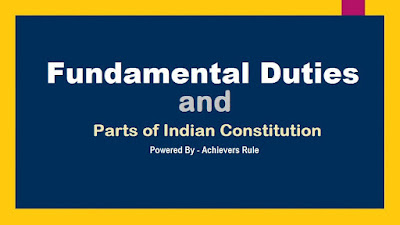 Fundamental Duties and Parts of Constitution
Fundamental Duties and Parts of Constitution

Important Bullet Points:
The Fundamental Duties were included in the Constitution with idea of – curbing subversive and unconstitutional activities.
The Fundamental Duties were included in the Constitution with idea of – curbing subversive and unconstitutional activities.
- Part VII was deleted by the 7th Amendment Act (1956).
- Part IV-A and Part XIV-A were added by the 42nd Amendment Act (1976).
- Part IX-A was added by the 74th Amendments Act (1992).
- Part IX-B was added by the 97th Amendment Act (2011).
Background of Fundamental Duties:
- These were added on the recommendation of Swaran Singh Committee (1976).
- This committee recommended for the inclusion of 8 fundamentals duties; this amendment included 10 fundamental duties.
- The Fundamental Duties are borrowed from USSR.
- The 10 Fundamental Duties were added to the Constitution in the year 1976 through 42nd Amendment.
- The 11th F.D. was added in the year 2002. Through 86th Amendment.
List of 11th Fundamental Duties:
These Duties are laid down in the Article 51A.
- To abide by the Constitution and respect is ideals and institutions, the National Flag and National Anthem.
- To Cherish and follow the noble ideals which inspired our national struggle for freedom.
- To uphold and protect the sovereignty, Unity and Integrity of India.
- To defend the country and render national Service when called upon so.
- To promote harmony and the spirit of common brotherhood amongst all the people of India transcending religious, linguistic and regional or sectional diversities to renounce practices derogatory to the dignity of women.
- To value and preserve the rich heritage of our composite culture.
- To protect improve the natural environment including forests, lakes, rivers and wild life and to have compassion for living creatures.
- To develop scientific temper, humanism and the sprite of inquiry and reform.
- To safeguard public property and adjure violence.
- To strive towards excellence in all Spheres of individual and collective activity, so that the nation constantly rises to higher levels of endeavour and achievement.
- Every parent or guardian to provide opportunity for education to his/her child or ward between the age of 6 & 14.
Parts of India Constitutionat at a glance:
Parts
|
Subject
Matter
|
Article
Covered
|
I
|
The
Union and its territory
|
1
to 4
|
II
|
Citizenship
|
5
to 11
|
III
|
Fundamentals
Rights
|
12
to 35
|
IV
|
Directive
Principle of State Policy
|
36
to 51
|
IV-A
|
Fundamentals
Duties
|
51-A
|
V
|
The
Union Government
|
52
to 151
|
Chapter
I – The Executive
|
52
to 78
|
|
Chapter
II – Parliament
|
79
to 122
|
|
Chapter
III – Legislative Powers of President
|
123
|
|
Chapter
IV- The Union Judiciary
|
124
to 147
|
|
Chapter
V – Comptroller and Auditor –General of India
|
148
to 151
|
|
VI
|
The
State Government
|
152
to 237
|
Chapter
I – General
|
152
|
|
Chapter
II – The Executive
|
153
to 167
|
|
Chapter
III – The State Legislature
|
168
to 212
|
|
Chapter
IV – Legislative Powers of Governor
|
213
|
|
Chapter
V – The High Court
|
214
to 232
|
|
Chapter
VI – Subordinate Courts
|
233
to 237
|
|
VII
|
The
States in Part B of he First Schedule (deleted)
|
238
(deleted)
|
VIII
|
The
Union Territories
|
239
to 242
|
IX
|
The
Panchayats
|
243
to 243-0
|
IX-A
|
The
Municipalities
|
243-P
to 243-ZG
|
IX-B
|
The
Co-operative Societies
|
243-ZH
to 243- ZT
|
X
|
The
Scheduled and Tribal Areas
|
244
to 244-A
|
XI
|
Relations
between the Union and States
|
245
to 263
|
Chapter
I – Legislative Relations
|
245
to 255
|
|
Chapter
II – Administrative Relations
|
256
to 263
|
|
XII
|
Finance,
Property, Contracts and Suits
|
264
to 300-A
|
Chapter
I – Finance
|
264
to 291
|
|
Chapter
II – Borrowing
|
292
to 293
|
|
Chapter
III – Property, Contracts, Rights, Liabilities, Obligations and Suits.
|
294
to 300
|
|
Chapter
IV – Right to Property
|
300-A
|
|
XIII
|
Trade,
Commerce and Intercourse within the Territory of India.
|
301
to 307
|
XIV
|
Service
under the Union and the States
|
308
to 323
|
Chapter
I – Service
|
308
to 314
|
|
Chapter
II – Public Service Commissions.
|
315
to 323
|
|
XIV-A
|
Tribunals
|
323-A
to 323-B
|
XV
|
Elections
|
324
to 329-A
|
XVI
|
Special
Provisions relating to Certain Classes
|
330
to 342
|
XVII
|
Official
Language
|
343
to 351
|
Chapter
I – Language of the Union
|
343
to 344
|
|
Chapter
II – Regional Language
|
345
to 347
|
|
Chapter
III – Language of the Supreme Court, High Court, and so on
|
348
to 349
|
|
Chapter
IV – Special Directives
|
350
to 351
|
|
XVIII
|
Emergency
Provisions
|
352
to 360
|
XIX
|
Miscellaneous
|
361
to 367
|
XX
|
Amendment
of the Constitution
|
368
|
XXI
|
Temporary,
Transitional and Special Provisions
|
369
to 392
|
XXII
|
Short
title, Commencement, Authoritative Text in Hindi and Repeals
|
393
to 395
|










Post a Comment